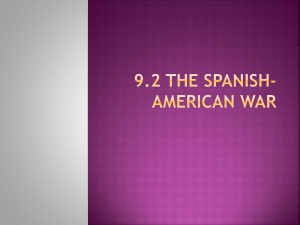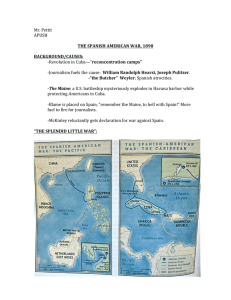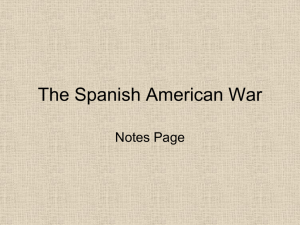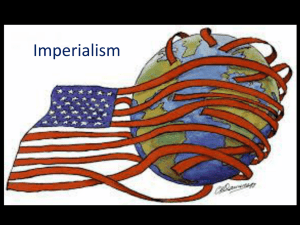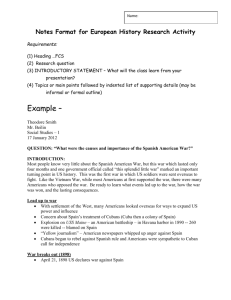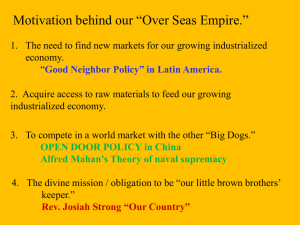Creating an Empire, 1865-1917 Lecture/Reading Notes 2 (p.174-181) III. The Spanish-American War
advertisement
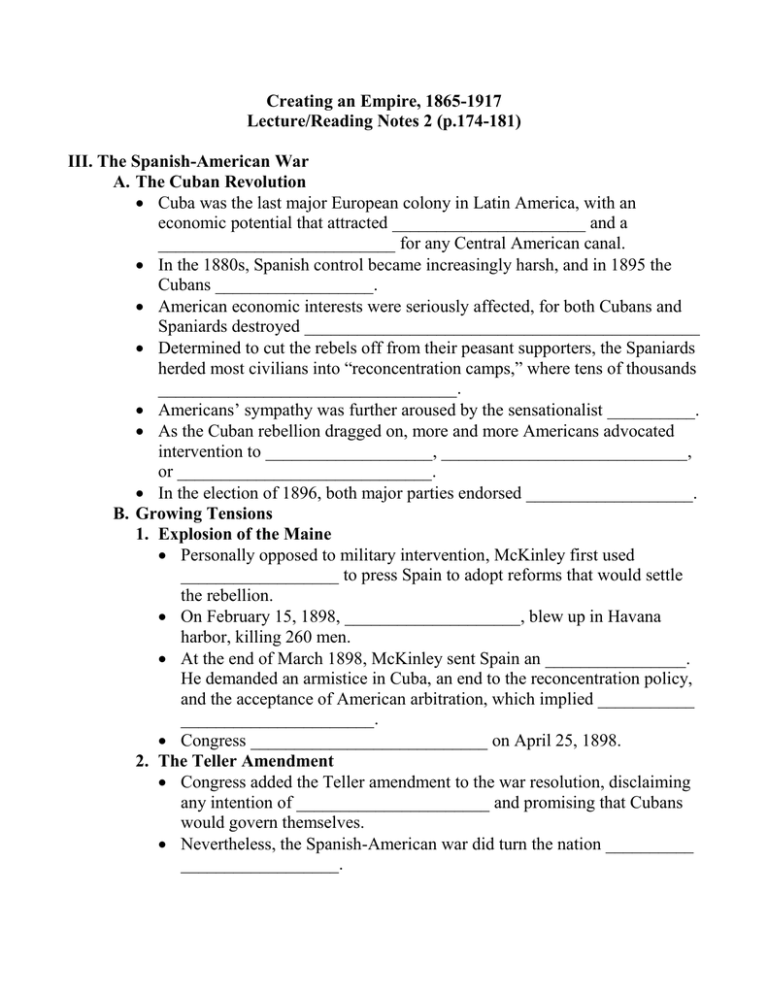
Creating an Empire, 1865-1917 Lecture/Reading Notes 2 (p.174-181) III. The Spanish-American War A. The Cuban Revolution Cuba was the last major European colony in Latin America, with an economic potential that attracted ______________________ and a ___________________________ for any Central American canal. In the 1880s, Spanish control became increasingly harsh, and in 1895 the Cubans __________________. American economic interests were seriously affected, for both Cubans and Spaniards destroyed _____________________________________________ Determined to cut the rebels off from their peasant supporters, the Spaniards herded most civilians into “reconcentration camps,” where tens of thousands __________________________________. Americans’ sympathy was further aroused by the sensationalist __________. As the Cuban rebellion dragged on, more and more Americans advocated intervention to ___________________, ____________________________, or _____________________________. In the election of 1896, both major parties endorsed ___________________. B. Growing Tensions 1. Explosion of the Maine Personally opposed to military intervention, McKinley first used __________________ to press Spain to adopt reforms that would settle the rebellion. On February 15, 1898, ____________________, blew up in Havana harbor, killing 260 men. At the end of March 1898, McKinley sent Spain an ________________. He demanded an armistice in Cuba, an end to the reconcentration policy, and the acceptance of American arbitration, which implied ___________ ______________________. Congress ___________________________ on April 25, 1898. 2. The Teller Amendment Congress added the Teller amendment to the war resolution, disclaiming any intention of ______________________ and promising that Cubans would govern themselves. Nevertheless, the Spanish-American war did turn the nation __________ __________________. C. War and Empire 1. War in the Philippines The decisive engagement of the war took place not in Cuba but in another Spanish colony, __________________, and it involved the favored tool of the expansionists, ____________________________. The navy had long coveted Manila Bay as a strategic harbor, but other Americans, casting an eye on ______________________________, saw a greater significance in the victory. Commodore George Dewey’s victory also precipitated the ___________ _________________. Annexationists now pointed to the islands’ strategic importance as steppingstones to Manila. 2. War in Cuba Military victory also _____________________________, once the U.S. Army finally landed in late June. ___________________________ again proved decisive. In a lopsided battle on July 3, the obsolete Spanish squadron in Cuba was destroyed, isolating the Spanish army and guaranteeing its defeat. U.S. forces then seized the nearby Spanish colony of _______________ without serious opposition. Humbled, Spain signed an armistice ending the war on August 12. D. The Treaty of Paris 1. The question of the Philippines The armistice required Spain to _______________________, cede ___________________________ (a Pacific island between Hawaii and the Philippines), and allow Americans to __________________ pending the final disposition of the Philippines at a formal peace conference. McKinley knew that delay would permit the advocates of expansion to build _________________________________. McKinley was motivated to acquire the Philippines primarily by a determination to use the islands to strengthen America’s _____________ ______________________________________. McKinley believed the Filipinos __________________________, and he feared that ______________________ might seize the Philippines if the United States did not. Spain agreed – ___________________________________ – to cede the Philippines to the United States. On February 6, 1899, the Senate narrowly ratified the treaty. Then, by a single vote, the ______________________________________________ ______________________________ once a stable government had been established; the United States would keep the islands. 2. The election of 1900 William Jennings Bryan attempted to make the election of 1900 a referendum on “the paramount issue” of _________________, promising to free the Philippines if the Democrats won. Bryan lost again, as in 1896, and under Republican leadership, the United States became ____________________________. IV. Imperial Ambitions: The United States and East Asia, 1899-1917 A. The Filipino-American War 1. Emilio Aguinaldo and the quest for Filipino independence Emilio Aguinaldo, welcomed Dewey’s naval victory as a de facto alliance with the United States; he then issued a declaration of independence and proclaimed the _______________________________. When the Treaty of Paris provided for U.S. ownership rather than independence, ________________________________. Mounting tensions erupted in a battle between American and Filipino troops outside Manila on February 4, 1899, sparking a _______________ _____________________. 2. Suppression of the Filipino rebellion Ultimately, the United States used _______________________________ to suppress the Filipinos as to defeat Spain in Cuba and, in tragic irony, employed many of the same brutal methods for which it had condemned Spain. By 1902, the American military had largely suppressed the rebellion, and the United States ____________________________________________. William Howard Taft, the first governor general, launched a program that brought the islands new schools and roads, a public health system, and an ______________________________________________________ and a small Filipino elite. B. China and the Open Door 1. European spheres of influence in China Japan, after defeating China in 1895, __________________________ and secured economic privileges in the mainland province of Fukien. The major European powers competed aggressively to claim other areas of China as their own ______________________________. The American business community was confident that given an equal opportunity, the United States __________________________________ because of efficient production and marketing systems. 2. The Open Door Notes In 1899, Secretary of State John Hay asked the imperial powers to maintain an Open Door for ____________________________________ of all nations within their Chinese spheres of influence. In 1900, an anti-foreign Chinese nationalist movement known as the Boxers laid siege to the diplomatic quarters in Beijing. The Open Door became _______________________________________ in the twentieth century. C. Rivalry with Japan and Russia 1. The Treaty of Portsmouth The Japanese and Russians expressed little support for the Open Door, which they correctly saw as favoring American interests over their own. By pursuing their ambitions in China, the two came into conflict with each other. _______________________________________________ in 1904 and defeated the Russians in Manchuria. In the Treaty of Portsmouth in 1905, Japan won control of Russia’s ____________________________________, half the Russian island of Sakhalin, and recognition of its domination of Korea. 2. The Gentlemen’s Agreement The treaty marked Japan’s emergence as a great power, but ironically, it ____________________________ with the United States. Under the Gentlemen’s Agreement, Japan agreed not to issue passports to workers coming to the United States, and the United States promised not to ________________________________ or completely. To calm their mutual suspicions in East Asia, the United States and Japan adopted other agreements but failed to ___________________________ __________________.
